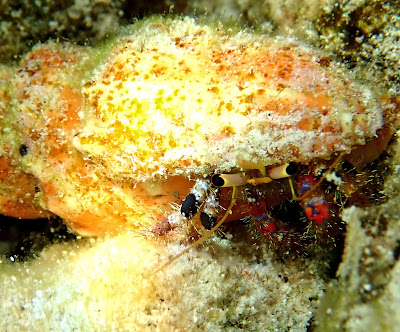Fishes Seen and Identified In Kahalu'u Bay, Kailua-Kona , Hawai'i
Identified by Bill and June Wagoner - In the mid 1980's
(Note: Order of listing follows Spencer Wilkie Tinker,
but a few English or Latin names have been changed
to agree with newer books by John E. Randall and others.)
Lizard Fish (Symodus variegatus)
Snowflake Moray (Echidna nebulosa)
Guines Moray (Gymnothorax meleagris) Whitemouth Moray
Yellow Margin Moray (Gymnothorax flavimarginatus)
Undulated Moray (Gymnothorax undulatus)
Conger Eel (Conger cinereus)
Snake Eel (Ophichthus polyophthalmus) An exceedingly rare snake eel
Needle Fish (Belone platyura) Keeltailed Needlefish
Trumpet Fish (Aulostoma chinensis)
Cornet Fish (Fistularia petimba)
Squirrel Fish (Myripristis kuntee)
Barracuda (Sphyraena barracuda)
Argus Grouper (Cephalopholis argus)
Hawaiian Flagtail (Kuhlia sandvicemsis)
Iridescent Cardinalfish (Apogon snyderj)
White Goatfish (Mulloides flavolineatus) Square spot, Yellow stripe
Yellowstripe Goatfish (Mulloides vanicolensis) Yellowfin
Doublebar Goatfish (Parupeneus bifasciatus)
Blue Goatfish (parupeneus cyclostomus)
Black Banded Goatfish (parupeneus multifasciatus) Manybar Goatfish
Whitesaddle Goatfish (parupeneus porphyreus)
Rudderfish (Kyphosus cinerescens) We now play four species species of chub
Potter's Angelfish (Cenropyge potteri)
Longnose Butterfly Fish (Forcipeger longirost)
Threadfin Butterfly Fish (Chaetodon auriga)
Citron Butterfly Fish (Chaetodon citrinnellus)
Bluestripe Butterfly Fish (Chaetodon fremblii)
Lined Butterfly Fish (Chaetodon lineolatus)
Raccoon Butterfly Fish (Chaetodon lumula)
Milletseed Butterfly Fish (Chaetodon miliaris)
Pebbled Butterfly Fish (Chaetodon multicinctus)
Ornate Butterfly Fish (Chaetodon ornatissamus)
Fourspot Butterfly Fish (Chaetodon quadrimaculatus)
Rainbow Butterfly Fish (Chaetodon trifasciatus) species name change
lunulatus Oval
Teardrop Butterfly Fish (Chaetodon unimaculatus)
Yellowtailed Jack (Caranx mate) ?Big eye scad, common at pier,not found at Kahalu'u
Blue Jack (Caranx melampygus) blue fin trevally
Dark Finned Damsel (Chromis agilis) Agile Chromis
White Spotted Damsel (Dascyllus albissella) Hawaiian Dascyllus
Sargent Major Damsel (Abudefduf abdominalis)
Olive Damsel (Abudefduf imparipennis) Bright eye Damsel
Kupipi Damsel (Abudefduf sordidus)
Blue Eyed Damsel (Plectroglyphidodon johnston)
Jenkin's Damsel (Pomacentrus jenkinsi) Hawaiian Gregory
Vanderbilt's Damsel (Chromis vanderbilti) Blackfin Chromis
Cigar Wrasse (Bodianus bilunulatus) Cigar Wrasse Chelio inermis , or Haw. Hogfish Bodianus bi..
Cleaner Wrasse (Labroides phthironphagus)
Rockmover Wrasse (Novaculichthys taeniourus)
Old Lady Wrasse (Thalassoma ballieui)
Saddle Wrasse (Thalassoma dubperrey)
Christmas Wrasse (Thalassoma fuscum)
Bird Wrasse (Gomphosus varius)
Black Striped Wrasse (Coris flavovittata)
Yellowtail Wrasse (Coris gaimardi)
Elegant Wrasse (Coris venusta)
Belted Wrasse (Stethojulis balteata)
Speckled Wrasse (Macropharyngodon meleagris) Shortnose Wrasse
Spotted Wrasse (Anampses cuvler) Pearl Wrasse
Redlip Parrotfish (Scarops rubroviolaceus)
Regal Parrotfish (Scarus dubius)
Palenose Parrotfish (Scarus psittacus))
Banded Nose Parrotfish (Scarus perspicillatus)
Sordid Parrotfish (Pearus sordious Bullethead Parrotfish
Stareye Parrotfish (Colototomus spinidena)
Arc-eye Hawkfish (Parecirrhites arcatus)
Freckled Hawkfish (Parecirrhites fosteri)
Hard Headed Hawkfish (Cirrhitus pinnulatus) Stocky Hawkfish
Short Bodied Blenny (Exallias brevis)
Common Blenny (Cirripectus variolosus) Scarface Blenny
Achilles Tang (Acanthurus achilles)
Hawaiian Surgeon (Acanthurus dussumieri)
White Banded Surgeon (Acanthurus leucopareius)
Ring Tailed Surgeon (Acanthurus mata)
Brown Surgeon (Acanthurus nigrofuscus)
Blue Lined Surgeon (Acanthurus nigrois)
Orange Shoulder Surgeon (Acanthurus olivaceus)
Kole Surgeon (Ctenochaetus strigosus)
Yellow Tang (Zebrasoma flavescens)
Convict Tang (Acanthurus sandvicensis)
Sailfin Tang (Zebrasoma veliferum)
Smoothhead Unicorn (Naso lituratus)
Large Unicorn (Naso unicornis)
Moorish Idol (Zanclus cornutus)
Devil Scorpionfish (Scorpaenopsis diabolus)
Flying Gunard (Dactyloptena orientalis)
Common Flounder, Manyray Flatfish (Bothus Mancus)
Black Triggerfish (Melichthys niger)
Pinktail Triggerfish (Melichthys vidua)
Rectangular Triggerfish (Rhinecannthus rectangulus)
Whiteline Triggerfish (Sufflamen bursa)
Dumeri's Filefish (Cantherhines dumerlii) Barred Filefish
Brown Filefish (Cantherhines sandwichiensis)
Longtail Filefish (Alutera scripta) Scribbled Filefish
Fantail Filefish (pervagor spilosoma)
Blue-Lined Leather Jacket (Osbeckia scripta) Scribbled Filefish
Blue Boxfish (Ostracion meleagris)
Spotted Green Puffer (Arothron hispidus) Stripe belly Puffer
Speckled Puffer (Arothron meleagris) Guineafowl Puffer
Whitespotted Puffer (Canthigaster jactator) White spotted toby
Common Porcupinefish (Diodon holacanthus) Longspine Porcupinefish
Giant Porcupinefish (Diodon hystrix) Giant Porcupinefish
Seen on outside of Breakwater of the Bay:
Whitetipped Reef Shark (Triaendon obesus)
Striped Porgy (Monotaxis grandoculis) The Mu Big eye Emperor
Mustard Surgeon (Acanthurus guttatus) White Spotted Surgeon
Black Surgeon (Ctenochaetus hawaiiensis)
(Note: We have not included several seen which
lack our positive identification)
TOTAL: 108 !!!
from the desk of Dick Dresie
(Dick the Diver)






























